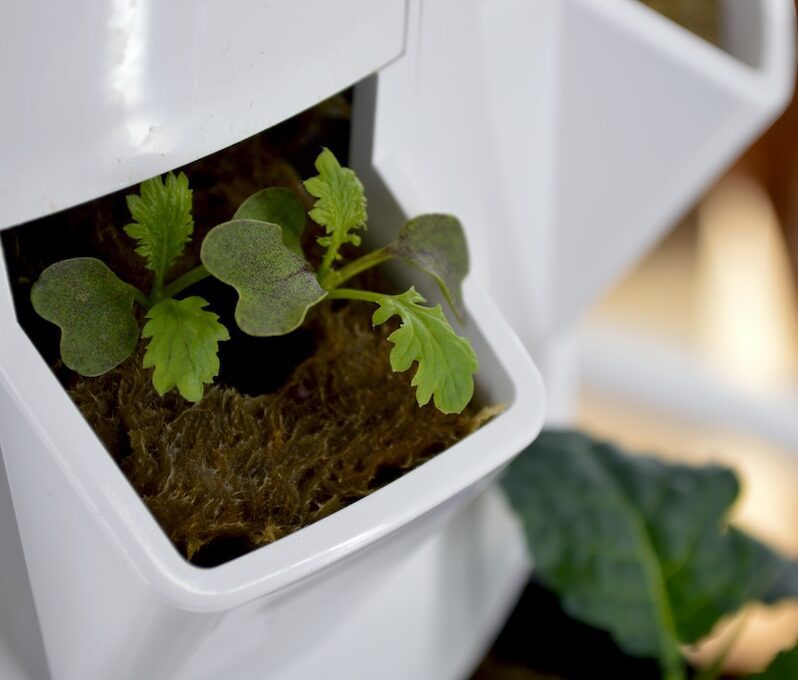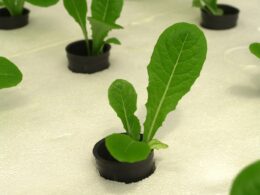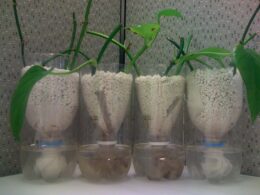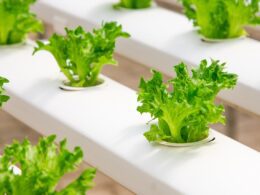Are you interested in growing tomatoes hydroponically but unsure which container to use? With so many options available, it can be overwhelming to decide which one is best for your needs. But fear not, we’ve got you covered!
In this article, we’ll explore the top containers for growing tomatoes hydroponically and the advantages and disadvantages of each one.
First, it’s important to understand the basics of hydroponics. This method of growing plants without soil involves using a nutrient-rich water solution to feed the plants directly. Hydroponic systems can vary in size, complexity, and the type of container used.
By choosing the right container, you can ensure that your tomato plants thrive and produce delicious fruit. So, let’s dive in and discover the best container options for your hydroponic tomato garden.
Understand Your Hydroponic System
Get ready to discover the secrets of a successful hydroponic system, so you can watch your plants thrive like never before.
Before you can choose the best container for growing tomatoes hydroponically, it’s important to understand the different types of hydroponic systems available. There are six main types of hydroponic systems: deep water culture, nutrient film technique, drip irrigation, ebb and flow, aeroponics, and wick system.
Each system has its own unique advantages and disadvantages, so it’s important to choose the one that is best suited for your needs. Factors affecting plant growth in hydroponics include pH levels, nutrient solutions, temperature, humidity, and lighting.
Proper pH levels are critical to the success of your hydroponic system, as they directly affect the ability of plants to absorb nutrients. Nutrient solutions must be carefully measured and balanced to provide the right amount of nutrients to your plants.
Temperature and humidity levels must be carefully controlled to ensure optimal growth conditions, while proper lighting is essential for photosynthesis. In summary, choosing the best container for growing tomatoes hydroponically is just one piece of the puzzle.
To achieve optimal growth and yield, it’s important to understand the different types of hydroponic systems available and the factors that affect plant growth in hydroponics. By taking the time to research and choose the right system for your needs, and carefully monitoring pH levels, nutrient solutions, temperature, humidity, and lighting, you can create a thriving hydroponic garden that will provide you with fresh, delicious tomatoes year-round.
Top Containers for Growing Tomatoes Hydroponically
If you’re looking for the best containers to grow tomatoes hydroponically, Dutch Buckets, Grow Bags, and Tower Gardens are all great options to consider. Dutch Buckets are ideal for larger plants, while Grow Bags are perfect for those who want a more portable option. Tower Gardens are great for those who want to save space and grow vertically.
So, depending on your needs and preferences, any of these containers could be a great choice for your hydroponic tomato growing setup.
Dutch Buckets
You can use Dutch Buckets, which are sturdy black containers with a white lid, to cultivate your juicy and plump tomatoes. One of the advantages of using Dutch Buckets is that they’re versatile and can be used for growing a variety of plants. They’re also easy to set up and maintain, making them a great option for beginners.
However, Dutch Buckets do have some disadvantages, such as the need for a drainage system and the potential for algae growth if not properly managed.
When it comes to nutrient solutions, Dutch Buckets require a balanced mix of macronutrients and micronutrients. Some recommended nutrient solutions for hydroponic tomato growing in Dutch Buckets include FloraGro, FloraMicro, and FloraBloom. These solutions provide essential nutrients such as nitrogen, phosphorus, and potassium, which are necessary for healthy plant growth.
With proper care and attention, Dutch Buckets can provide a stable and reliable system for growing delicious tomatoes hydroponically.
Grow Bags
Looking for a new way to cultivate your favorite plants? Consider using grow bags in your hydroponic setup for a unique and convenient option. These bags are typically made of sturdy materials like fabric or plastic, and they come with a variety of benefits that make them a popular choice for hydroponic gardeners.
Here are some pros and cons of using grow bags, as well as a comparison of different materials:
-
Pros: Grow bags are lightweight and easy to move around, making them a great option for gardeners who need to adjust their setup frequently. They also offer good drainage and aeration, which helps prevent overwatering and root rot. Additionally, grow bags can be reused for multiple growing seasons, making them an eco-friendly option.
-
Cons: Some growers have reported issues with mold and algae growth on the bags, which can be unsightly and potentially harmful to plants. Additionally, grow bags can be prone to drying out quickly, especially in hot or dry environments.
-
Comparing Materials: Fabric grow bags are the most popular option, as they offer good drainage and aeration. However, plastic bags are a more affordable option and can be a good choice for short-term use. Biodegradable bags are also available, but they may break down too quickly for some growers.
Tower Gardens
Tower gardens offer a unique and space-saving way to grow a variety of plants, including tomatoes. With vertical farming and aeroponic systems, tower gardens allow for plants to grow in a compact space while still receiving the necessary nutrients and water.
This is especially beneficial for urban gardeners or those with limited outdoor space. One of the biggest advantages of tower gardens is their ability to produce high yields of tomatoes. In fact, some tower gardens have been known to produce up to 30 pounds of tomatoes in just one harvest!
Additionally, tower gardens are easy to maintain and don’t require soil, making them a clean and efficient option for growing tomatoes hydroponically. So if you’re looking for a way to grow tomatoes in a limited space, consider using a tower garden for vertical farming and aeroponic systems.
Advantages and Disadvantages of Each Container Type
Explore the pros and cons of each option to make an informed choice that fits your unique needs and goals, so you can ensure the health and vitality of your plants. When it comes to choosing the right container for your hydroponic tomatoes, there are several options to consider. Here are four factors to keep in mind:
-
Material: Plastic containers are lightweight and easy to move, but they may not be as durable as other options. Clay pots, on the other hand, are heavier and offer better stability, but they can be more expensive.
-
Drainage: Proper drainage is essential for the health of your tomato plants. Plastic containers often come with pre-drilled holes, while clay pots may require drilling.
-
Size: The size of your container will depend on the number of plants you want to grow. Larger containers offer more room for the roots to spread, but they may be more difficult to move around.
-
Cost: The cost of your container will depend on the material, size, and features. While plastic containers are often the most affordable option, they may not offer the same level of durability as other materials.
Consider these factors carefully before making your decision.
Ultimately, the best container for your hydroponic tomatoes will depend on your unique needs and goals. Plastic containers are a good choice for those on a budget, while clay pots offer better stability and durability. Consider the size of your container and the drainage options available to ensure the health and vitality of your plants. By exploring the pros and cons of each option, you can make an informed choice that will help you achieve your gardening goals.
Can Tomatoes Be Grown Hydroponically and What Other Foods Can Be Grown this Way?
Tomatoes are one of the many foods that can be hydroponically grown. This innovative method involves cultivating plants without soil, using nutrient-rich solutions. Besides tomatoes, a variety of other crops thrive in hydroponic systems, including lettuce, peppers, cucumbers, herbs, and even strawberries. The controlled environment allows for higher yields, enhanced nutrient absorption, and year-round cultivation, making it an attractive option for modern farming.
Care Tips for Your Hydroponic Tomato Plants
To ensure your hydroponic tomato plants thrive, you’ll need to know how to care for them properly. One of the most important things you can do for your plants is to prune them regularly. Pruning techniques such as removing suckers and pinching off the tops of plants can help promote better fruit production and prevent disease.
Another crucial aspect of caring for hydroponic tomato plants is making sure they receive the proper nutrient solutions. You should be checking the pH levels of your nutrient solutions regularly and adjusting them as needed. Additionally, you’ll want to make sure that your plants are getting all the necessary nutrients they need, such as nitrogen, phosphorus, and potassium.
In order to make sure your hydroponic tomato plants are as healthy as possible, it’s important to keep a close eye on them and make adjustments as needed. This can include adjusting the lighting, temperature, and humidity levels in your growing area, as well as monitoring the air circulation and water levels. With the right care, your hydroponic tomato plants can thrive and produce delicious, juicy fruit for you to enjoy.
| Table of Common Pruning Techniques | Benefits | ||
|---|---|---|---|
| Removing suckers | Promotes better fruit production | ||
| Pinching off tops of plants | Prevents disease | ||
| Removing yellow or dead leaves | Prevents the spread of disease | ||
| Removing lower leaves | Improves air circulation | ||
| Removing flowers or fruit | Encourages larger fruit production | by redirecting the plant’s energy towards fewer, but bigger, fruits. |
Harvesting and Enjoying Your Hydroponic Tomatoes
Now that you’ve nurtured your hydroponic tomato plants to maturity, it’s time to reap the delicious rewards and enjoy the fruits of your labor. But, what do you do with all of those juicy tomatoes?
There are a few ways to preserve them so you can enjoy them all year round. One popular method is freezing. Simply wash and dry the tomatoes, then place them in a freezer-safe container or bag. You can freeze them whole or slice them first. Frozen tomatoes are great for adding to soups, stews, or sauces.
If you’re looking for creative recipes for cooking with hydroponic tomatoes, the possibilities are endless. One tasty option is to make a caprese salad with fresh basil and mozzarella. Another idea is to roast the tomatoes with garlic and herbs, then use them as a topping for crostini or pasta. You can also make a delicious tomato sauce for pizza or pasta by blending the tomatoes with garlic, onion, and your favorite seasonings.
In addition to preserving and cooking with your hydroponic tomatoes, don’t forget to enjoy them fresh! Sliced tomatoes are a great addition to sandwiches or salads. You can also make a refreshing gazpacho soup with tomatoes, cucumber, and bell pepper.
Whatever method you choose, the taste of homegrown hydroponic tomatoes is sure to impress. So, get creative and savor the flavors of your hard work!
Frequently Asked Questions
What is the best type of nutrient solution to use for hydroponic tomato plants?
To ensure the best growth for your hydroponic tomato plants, it’s important to manage the pH levels of your nutrient solution. By doing so, you can ensure that your plants are receiving the optimal balance of nutrients.
Preparation of your nutrient solution is also crucial, as it will provide your plants with the necessary elements for healthy growth. To prepare your nutrient solution, follow the instructions on the package and be sure to measure accurately.
By managing pH levels and preparing your nutrient solution properly, you can give your hydroponic tomato plants the best chance for success.
How often should I change the nutrient solution in my hydroponic tomato container?
To maintain healthy hydroponic tomato plants, it’s important to change the nutrient solution in your container frequently. The frequency recommendation varies depending on the nutrient concentration and the stage of growth your plants are in.
As a general rule, most growers change the solution every two weeks. However, if you notice that your plants are showing signs of nutrient deficiencies or the pH is unstable, it’s best to change the solution more frequently.
Keep in mind that maintaining the proper nutrient balance is crucial for your plants’ overall health and productivity. So, make sure to monitor the nutrient solution and adjust accordingly to ensure optimal growth.
Can I reuse the nutrient solution from a previous hydroponic tomato crop?
If you’re planning to reuse the nutrient solution from a previous hydroponic tomato crop, it’s important to keep in mind that the pH level of the solution needs to be properly managed.
Before reusing the solution, test the pH level and adjust it as needed to ensure that it falls within the ideal range for tomato growth.
It’s also important to note that the nutrient solution may have become depleted of certain nutrients during the previous crop, so adding fresh nutrients may be necessary.
While nutrient solution reuse can be a cost-effective option, it’s important to monitor the pH level and nutrient levels closely to ensure that your plants are receiving the nutrients they need to thrive.
How do I prevent pests and diseases from affecting my hydroponic tomato plants?
To keep pests and diseases from ruining your hydroponic tomato plants, natural remedies and effective pest management are essential.
Start by keeping your growing area clean and free of debris, which can attract pests. Use a combination of integrated pest management techniques, such as introducing beneficial insects and using natural sprays like neem oil or garlic spray.
You can also try companion planting with herbs like basil or marigolds, which can repel pests. Regularly inspect your plants for signs of disease, such as yellowing leaves or spots, and promptly remove any affected foliage.
By taking these steps, you can ensure a healthy and thriving hydroponic tomato crop.
What is the expected yield of hydroponic tomato plants compared to traditional soil-grown tomato plants?
If you’re considering growing tomatoes hydroponically, you may be wondering how the yield compares to traditional soil-grown plants. A comparative analysis shows that hydroponic tomato plants tend to produce higher yields per square foot of space than soil-grown plants. This is due in part to the ability to control environmental factors such as nutrient levels, pH, and water availability more precisely in a hydroponic system.
However, it’s important to note that yield can vary depending on the specific growing conditions and the cultivar of tomato being grown. Ultimately, the best way to maximize yield is to optimize environmental conditions and choose high-yielding tomato varieties.
Conclusion
Congratulations on taking the first step in growing your own hydroponic tomatoes! Now that you understand your hydroponic system, it’s time to choose the best container for your plants.
There are many options available, including buckets, grow bags, PVC pipes, and more. Each container has its own advantages and disadvantages, so it’s important to do your research and choose the option that best fits your needs.
Once you have your container, it’s important to care for your hydroponic tomato plants properly. This includes monitoring pH levels, providing adequate light and nutrients, and pruning your plants regularly.
With proper care, you can enjoy a bountiful harvest of delicious, homegrown tomatoes. So go ahead and give it a try – you might just discover a new passion for hydroponic gardening!









